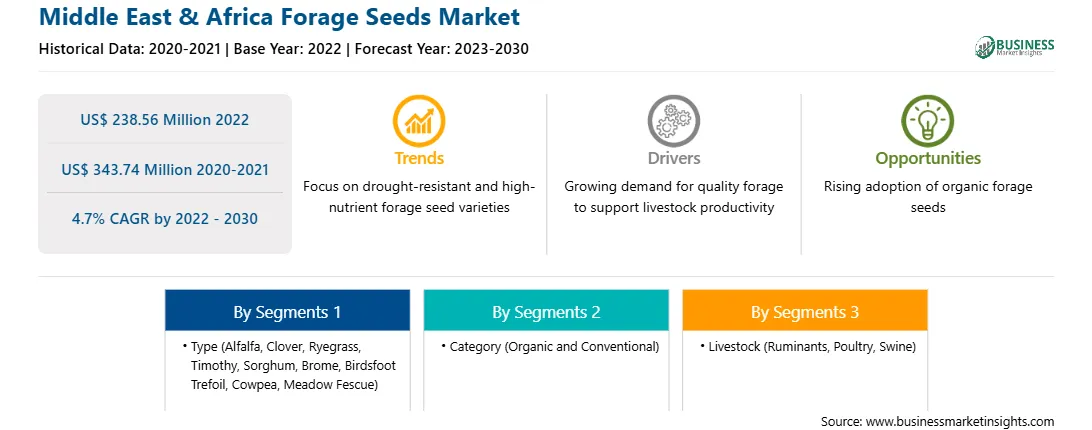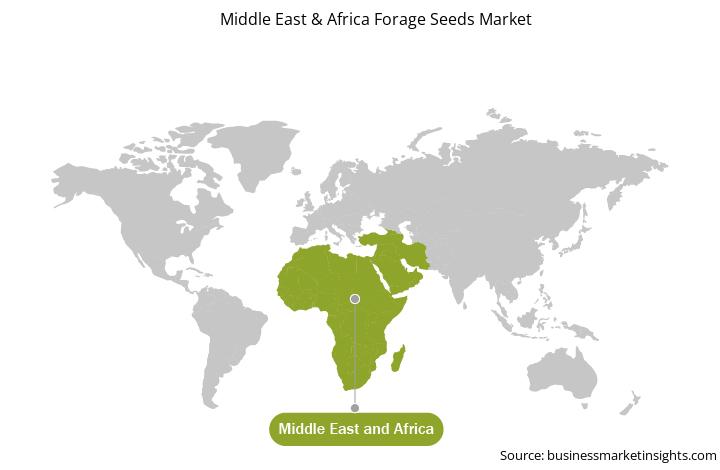The Middle East & Africa forage seeds market was valued at US$ 238.56 million in 2022 and is expected to reach US$ 343.74 million by 2030; it is estimated to grow at a CAGR of 4.7% from 2022 to 2030.
Rising Preference for Organic Feed Fuel the Middle East & Africa Forage Seeds Market
People are becoming more conscious about their health; thus, they prefer consuming organic food as it does not contain pesticides. Organic milk and meat are richer in nutrients such as enzymes, bioflavonoids, and antioxidants. Hence, people prefer organic food and organic meat over inorganic. This has led to the demand for organic feed to supply organic meat to consumers. Dairy farms, the poultry sector, and animal husbandry have focused on purchasing high-quality organic forage feed due to the growing demand for organic meat and dairy products. Conventional feed often contains high amounts of chemicals that hamper meat quality when consumed by animals. Long-term consumption of such meat results in various health disorders. To overcome this issue, manufacturers are developing organic feed that contains no chemical additives. Animals feeding on such feed offer meat that has high nutritional value. Thus, consumers often find organic and natural products as healthier alternatives to conventional products. Consumers are mainly inclined toward organic products, which has encouraged manufacturers to invest heavily in products produced with organic constituents. Furthermore, the more accessible access to infinite information with the help of the internet has made consumers increasingly aware of their health needs, leading to the increasing demand for organic feed. Thus, a rising preference for organic feed is expected to become a significant trend in the Middle East & Africa forage seeds market during the forecast period.
Middle East & Africa Forage Seeds Market Overview
The forage seeds market in the Middle East & Africa is segmented into South Africa, the UAE, and the Rest of Middle East & Africa. The growing demand for quality meat products in the Middle East is increasing the adoption of animal feed among livestock farms. As per the report of Alltech Global, South Africa, Oman, Egypt, Nigeria, Morocco, and Algeria are producing 65% of animal feed products in the Middle East & Africa. Furthermore, South Africa, Tanzania, Kenya, and Ethiopia are leading livestock farming nations in the region. Thus, increased livestock farming surged the demand for animal feed, such as forages, boosting the forage seeds market. Forage crop cultivation requires vital water resources and irrigated land. The government banned forage cultivation in November 2018 due to limited water resources in Saudi Arabia. However, the demand for forage is high due to high livestock production. To cater to the increasing demand, manufacturers have developed some technologies to import forage from other countries. For instance, the National Agricultural Development Company (NADEC), one of the Middle Easts largest dairy producers, is using cloud-based technology to help it overcome the operational hurdles created by the ban. NADEC has started growing alfalfa and other crops for cattle feed in Sudan, Jordan, Lebanon, and other countries. The crops are harvested and then transported back to the company's homeland dairy farm in Saudi Arabia. Cloud-based technology makes tracking shipments, analyzing delivery performance, and reconciling real-time payments easy. Such technological advancement by key regional players is expected to boost the forage seeds market in the future.
Middle East & Africa Forage Seeds Market Revenue and Forecast to 2030 (US$ Million) Strategic insights for the Middle East & Africa Forage Seeds provides data-driven analysis of the industry landscape, including current trends, key players, and regional nuances. These insights offer actionable recommendations, enabling readers to differentiate themselves from competitors by identifying untapped segments or developing unique value propositions. Leveraging data analytics, these insights help industry players anticipate the market shifts, whether investors, manufacturers, or other stakeholders. A future-oriented perspective is essential, helping stakeholders anticipate market shifts and position themselves for long-term success in this dynamic region. Ultimately, effective strategic insights empower readers to make informed decisions that drive profitability and achieve their business objectives within the market. The geographic scope of the Middle East & Africa Forage Seeds refers to the specific areas in which a business operates and competes. Understanding local distinctions, such as diverse consumer preferences (e.g., demand for specific plug types or battery backup durations), varying economic conditions, and regulatory environments, is crucial for tailoring strategies to specific markets. Businesses can expand their reach by identifying underserved areas or adapting their offerings to meet local demands. A clear market focus allows for more effective resource allocation, targeted marketing campaigns, and better positioning against local competitors, ultimately driving growth in those targeted areas.Middle East & Africa Forage Seeds Strategic Insights

Middle East & Africa Forage Seeds Report Scope
Report Attribute
Details
Market size in 2022
US$ 238.56 Million
Market Size by 2030
US$ 343.74 Million
Global CAGR (2022 - 2030)
4.7%
Historical Data
2020-2021
Forecast period
2023-2030
Segments Covered
By Type
By Category
By Livestock
Regions and Countries Covered
Middle East and Africa
Market leaders and key company profiles
Middle East & Africa Forage Seeds Regional Insights

Middle East & Africa Forage Seeds Market Segmentation
The Middle East & Africa forage seeds market is segmented based on type, category, livestock, and country. Based on type, the Middle East & Africa forage seeds market is segmented into alfalfa, clover, ryegrass, timothy, sorghum, brome, birdsfoot trefoil, cowpea, meadow fescue, and others. The alfalfa segment held the largest market share in 2022. The clover segment is further subsegmented into white, red, hybrid, and others. Additionally, the ryegrass segment is categorized into annual ryegrass, perennial ryegrass, Italian ryegrass, and hybrid ryegrass.
Based on category, the Middle East & Africa forage seeds market is bifurcated into organic and conventional. The conventional segment held a larger market share in 2022.
Based on livestock, the Middle East & Africa forage seeds market is segmented into ruminants, poultry, swine, and others. The ruminants segment held the largest market share in 2022.
Based on country, the Middle East & Africa forage seeds market is segmented into South Africa, the UAE, and the Rest of Middle East & Africa. The Rest of Middle East & Africa dominated the Middle East & Africa forage seeds market share in 2022.
UPL Ltd, Corteva Inc, S&W Seed Co, MAS Seeds SA, and Syngenta AG are some of the leading companies operating in the Middle East & Africa forage seeds market.
1. Corteva Inc
2. MAS Seeds SA
3. S&W Seed Co
4. Syngenta AG
5. UPL Ltd
The Middle East & Africa Forage Seeds Market is valued at US$ 238.56 Million in 2022, it is projected to reach US$ 343.74 Million by 2030.
As per our report Middle East & Africa Forage Seeds Market, the market size is valued at US$ 238.56 Million in 2022, projecting it to reach US$ 343.74 Million by 2030. This translates to a CAGR of approximately 4.7% during the forecast period.
The Middle East & Africa Forage Seeds Market report typically cover these key segments-
The historic period, base year, and forecast period can vary slightly depending on the specific market research report. However, for the Middle East & Africa Forage Seeds Market report:
The Middle East & Africa Forage Seeds Market is populated by several key players, each contributing to its growth and innovation. Some of the major players include:
The Middle East & Africa Forage Seeds Market report is valuable for diverse stakeholders, including:
Essentially, anyone involved in or considering involvement in the Middle East & Africa Forage Seeds Market value chain can benefit from the information contained in a comprehensive market report.